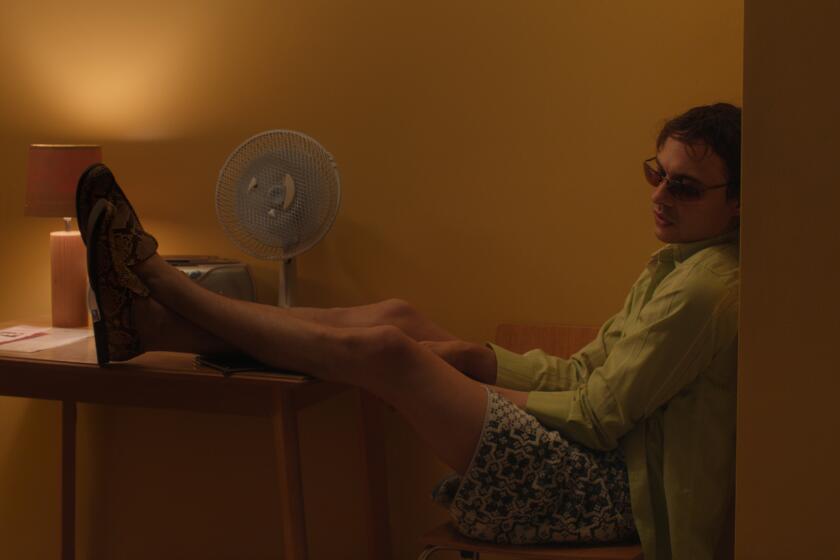MOVIE REVIEW : ‘Blaze’ Sizzles Even Over Low Flame
- Share via
In “Blaze”(selected theaters), the raucous and selectively true story of the love affair of Earl K. Long, the 63-year-old governor of Louisiana, and red-haired, 28-year-old burlesque queen Blaze Starr, Paul Newman throws himself into bringing every eccentric, disrespectful quirk of Ol’ Earl’s to life and he succeeds fiercely well.
A handful even for his day, Earl Long was a real pistol, the younger brother of the state’s greatest demagogue, Huey Long, and a genuine if unlikely advocate of black voting rights in 1959. To watch Newman’s frowsy-haired Long sweep confidently into a rowdy Bourbon Street strip joint is to reflect on what a tepid, joyless bunch politicians have shriveled into, post-television surveillance. Growly voiced and lickerish-eyed, Newman is audacious.
The one who has pulled back is writer-director Ron Shelton. How the maker of “Bull Durham” could have come this close and then have tip-toed away from a portrait as wild and as flamboyant as his subject’s is a question to ponder.
Ol’ Earl carried “progressive” ideas about the rights of the poor and blacks into action. He was considered outright crazy, there were questions of tax evasion, alcoholism, womanizing. And when he began his public affair with Starr, no stranger to publicity herself, his wife conspired with his political enemies to have him locked away in a Louisiana mental institution--three times. From this beleaguered position, because he couldn’t succeed himself as governor more than three times, he went on to run for Congress in 1960.
The movie truncates the political skirmishing that was Earl Long, leaving us with more questions than answers. Those who know nothing about him, going in, won’t even be sure that his stand against white supremacists in the Louisiana state legislature was real. It was.
And probably because the family wouldn’t allow it, there’s no mention of Long’s wife of almost 30 years. With no wife, we’re at a loss to understand what kept these two from marrying after Long’s public, ring-brandishing proposal. They so clearly loved each other.
Shelton certainly got the casting right, though. With her tumbling red hair and her pansy-shaped face, Lolita Davidovich is luscious and endearing all at once. There’s a nice easy style to her that seems a natural part of this fantasy woman. Lust aside, you can see how Long, this political animal, might also like talking to this bright, down-homey girl--whether a panther took her clothes off onstage or not.
Blaze’s transformation from Fannie Belle Fleming of Twelve Pole Creek, W. Va., to a savvy Baltimore stripper probably isn’t long enough for some. It’s positively streamlined from the book she wrote with Huey Perry, which provided the backbone of Shelton’s screenplay.
We don’t see enough of her act to know the sort of headliner Starr was, the kick she got from dreaming up her trademark gimmicks--like the panther, or a couch that seemed to burst into flame at the end of her routine. And Shelton doesn’t linger on the pleasure she took from her dancing. You only need to remember Valerie Perine’s strip in “Lenny,” courtesy of Bob Fosse, to know how powerful this material can be. Having whetted our interest, Shelton downplays that whole side of Blaze.
We do see her beginnings, as a scared, aspiring country singer in a servicemen’s bar during the Korean War, whistled onto a stage and asked if she won’t shed her clothes and undo her formidable white cotton bra “for America.” Bob Wuhl has a grand moment as the creepo emcee who lures her into it.
By the next scene, she’s trying to teach herself clockwise and counterclockwise with the tassels and before we know it, she’s a star, er, Starr. She’s learned patter, she’s learned back-combing and she knows exactly where to glue the sequins. And she’s learned to offer men a powder puff from the stage, to dust the derriere she also offers.
As for Long, his spellbinding side goes almost undemonstrated. The press notes, not the movie, give us the great Long quote: “The three best friends the poor people have ever had are Jesus Christ, Sears & Roebuck and Earl K. Long.” It’s electrifying to hear the old reprobate’s own voice under the closing credits and it gives a good idea how close Newman has come to capturing him. But speechifying like this comes on a roll, and “Blaze” never really gets its roll going.
As it stands, “Blaze” is hugely enjoyable, with fluid, sensual camera work by Haskell Wexler and Ruth Myer’s cheerfully outrageous costumes that savor every inch of Davidovich. There’s a real feeling about Long’s henchmen, Gailard Sartain in particular, as the aide who hates what Blaze is doing to the boss’ chances, but grudgingly comes to admire her spirit.
But “Blaze” is also puzzling. It peaks too soon, and having teased us with these legendary characters, it goes almost prim when it comes to seeing them in action. Short-sheeting, from the maker of “Bull Durham”? Who would have thought?
‘BLAZE’
A Touchstone Pictures release in association with Silver Screen Partners IV of an A&M; Films production. Producers Gil Friesen, Dale Pollock. Executive producers David Lester, Don Miller. Writer, director Ron Shelton, based on the book “Blaze Starr, My Life as Told to Huey Perry,” by Starr and Perry. Camera Haskell Wexler. Editor Robert Leighton. Music Bennie Wallace. Production design Armin Ganz. Art direction Edward Richardson, set decoration Michael J. Taylor, Rosemary Brandenburg. Costumes Ruth Meyers. Sound Kirk Francis. Associate producer Wendy Dozoretz. With Paul Newman, Lolita Davidovich, Gailard Sartain, Jerry Hardin, Jeffrey DeMunn, Robert Wuhl. Running time: 1 hour, 48 minutes.
MPAA-rated: R (under 17 requires accompanying parent or adult guardian).
More to Read
Only good movies
Get the Indie Focus newsletter, Mark Olsen's weekly guide to the world of cinema.
You may occasionally receive promotional content from the Los Angeles Times.








